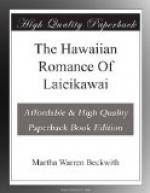INTRODUCTION
I. THE BOOK AND ITS WRITER; SCOPE OF THE PRESENT EDITION
The Laieikawai is a Hawaiian romance which recounts the wooing of a native chiefess of high rank and her final deification among the gods. The story was handed down orally from ancient times in the form of a kaao, a narrative rehearsed in prose interspersed with song, in which form old tales are still recited by Hawaiian story-tellers.[1] It was put into writing by a native Hawaiian, Haleole by name, who hoped thus to awaken in his countrymen an interest in genuine native story-telling based upon the folklore of their race and preserving its ancient customs—already fast disappearing since Cook’s rediscovery of the group in 1778 opened the way to foreign influence—and by this means to inspire in them old ideals of racial glory. Haleole was born about the time of the death of Kamehameha I, a year or two before the arrival of the first American missionaries and the establishment of the Protestant mission in Hawaii. In 1834 he entered the mission school at Lahainaluna, Maui, where his interest in the ancient history of his people was stimulated and trained under the teaching of Lorrin Andrews, compiler of the Hawaiian dictionary, published in 1865, and Sheldon Dibble, under whose direction David Malo prepared his collection of “Hawaiian Antiquities,” and whose History of the Sandwich Islands (1843) is an authentic source for the early history of the mission. Such early Hawaiian writers as Malo, Kamakau, and John Ii were among Haleole’s fellow students. After leaving school he became first a teacher, then an editor. In the early sixties he brought out the Laieikawai, first as a serial in the Hawaiian newspaper, the Kuokoa, then, in 1863, in book form.[2] Later, in 1885, two part-Hawaiian editors, Bolster and Meheula, revised and reprinted the story, this time in pamphlet form, together with several other romances culled from Hawaiian journals, as the initial volumes of a series of Hawaiian reprints, a venture which ended in financial failure.[3] The romance of Laieikawai therefore remains the sole piece of Hawaiian, imaginative writing to reach book form. Not only this, but it represents the single composition of a Polynesian mind working upon the material of an old legend and eager to create a genuine national literature. As such it claims a kind of classic interest.
The language, although retaining many old words unfamiliar to the Hawaiian of to-day, and proverbs and expressions whose meaning is now doubtful, is that employed since the time of the reduction of the speech to writing in 1820, and is easily read at the present day. Andrews incorporated the vocabulary of this romance into his dictionary, and in only a few cases is his interpretation to be questioned. The songs, though highly figurative, present few difficulties. So far as the meaning is concerned, therefore, the translation




